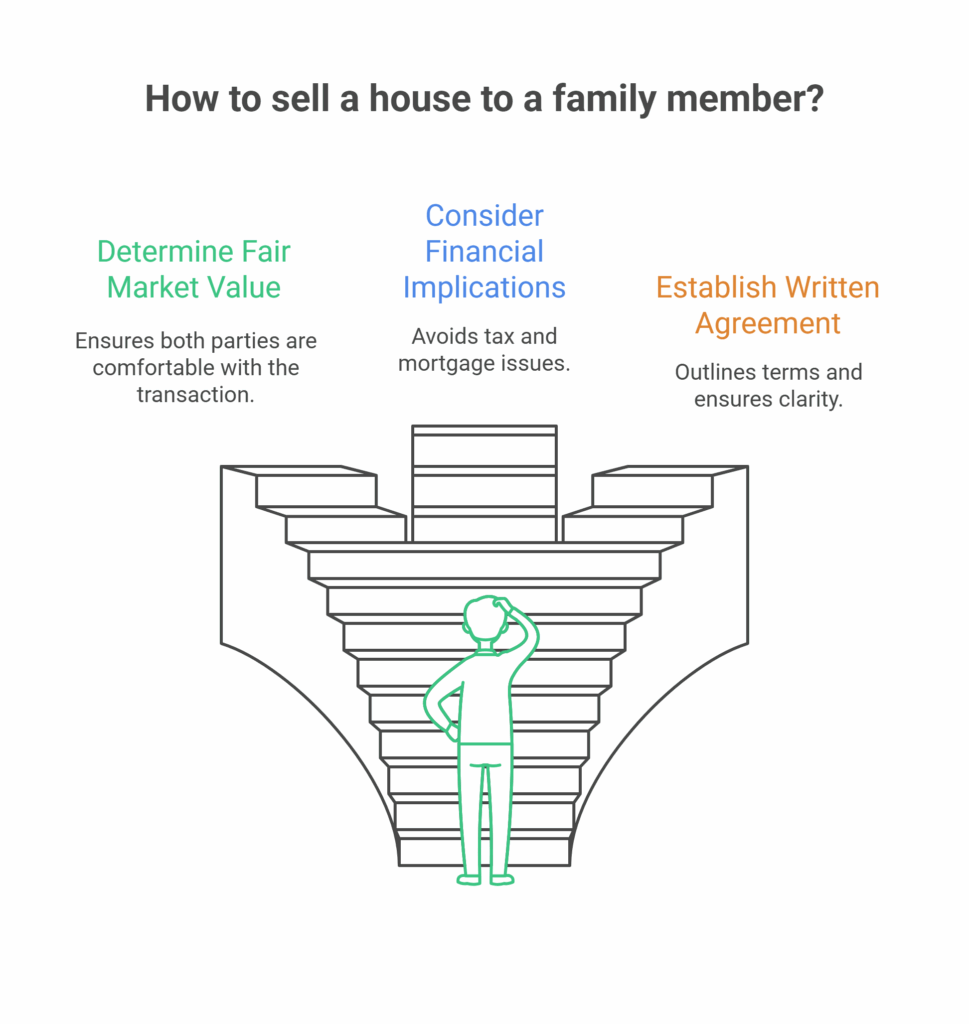Quick Answer: How to Sell a House to a Family Member?
How to Sell a House to a Family Member? The process involves more than just agreeing on a price—it requires proper documentation, fair market valuation, and sometimes legal or tax guidance. While selling to family can save on marketing and simplify negotiations, you’ll still need a formal purchase agreement, disclosures, and possibly lender approval if financing is involved.
Consulting a real estate attorney or tax professional ensures the transaction remains legal, transparent, and beneficial for both parties.
Now let’s dive deeper.

Why Is Selling a House to a Family Member Different?
When you sell a house to a family member, it is different from a standard real estate transaction. Since it is considered a non-arms length transaction for IRS purposes, it requires extra scrutiny against being considered a fraud or an avoidance of taxes or adjustment of property value among related buyers. The government thinks that family members may be trying to save each other from having to deal with a market-based transaction and hence develop closer scrutiny of such sales.
Arm’s Length vs. Non-Arm’s Length Transactions
- An arm’s length transaction is the sale of a typical house where the buyer and seller are unrelated and are negotiating based on market value.
- A non-arms-length transaction is a sale where the customers and sellers are related in a familial capacity, through partnerships, or friendship.
If you’re wondering how to sell a house to a family member, you’ll need to navigate a few extra steps to ensure the transaction meets legal and tax requirements.
Steps to Selling a House to a Family Member
1. Establish the Home-Selling Process
Before diving into paperwork, have a clear conversation with your relative about the logistics of the sale. Key questions to consider:
- Will they buy the home with a mortgage or cash?
- What’s the expected timeline?
- Will you involve a real estate agent or attorney?
- What happens if disagreements arise?
Being upfront about these details can prevent misunderstandings and keep Thanksgiving dinner from turning into a courtroom drama.
2. Hire a Real Estate Agent or Attorney
Even though you’re selling to family, having a neutral third party involved can ensure everything runs smoothly. A real estate agent or attorney can:
- Draft contracts and disclosures
- Conduct market research for pricing
- Manage negotiations professionally
- Prevent legal and tax-related surprises
If you’re thinking, “We don’t need a lawyer; we trust each other!”—trust me, that’s what everyone says before things go sideways.
3. Determine the Home’s Fair Market Value
Pricing the home correctly is crucial to avoid IRS scrutiny. The government wants to make sure you’re not undervaluing the home to avoid taxes or gifting large amounts of equity without proper documentation.
To determine fair market value, consider:
- Hiring a professional home appraiser
- Conducting a comparative market analysis (CMA) with a real estate agent
If you and the family member agree to a price for the property that is less than market value, you may have to deal with gift tax complications (more about this later). Knowing how to sell a house to a family member at the correct price will help to avoid future legal or tax implications.
4. Set a Reasonable Price
Once you have a fair market value estimate, decide how much to sell for. You can:
- Sell at market value (simplest option, avoids gift tax issues)
- Sell below market value (can trigger tax consequences, so plan carefully)
- Offer a gift of equity (the difference between market value and sale price counts as a gift and may be taxable)
The IRS allows up to $17,000 per year (as of 2023) in tax-free gifts per recipient. Anything above that may require filing a gift tax return.
5. Close the Sale
Closing with a family member may seem relaxed, but it still requires formal procedures. If they’re financing the home, the lender will require a standard title search, escrow process, and loan approval. Even in an all-cash deal, a lawyer should oversee the final contracts to ensure everything is legally binding.
Important Considerations When Selling to Family
1. Avoid Medicaid and Tax Fraud
Unfortunately, selling property below the market value may help family members qualify for Medicaid or reduce the taxable asset value but may land people into very bad legal trouble. Because most states have a five-year look-back period for Medicaid eligibility, so all these transactions from the past can come under scrutiny.
2. Get a Home Inspection
Do not disregard the inspection because of family! A home inspection shields everybody from unpleasant surprises that could cause disputes in the future regarding hidden defects.
3. Keep Emotions in Check
Finances and feelings can easily become entangled when selling to family members. Everything must be kept professional; treat it like a business transaction so as not to create misunderstandings or resentment later on. Truly learning how to sell a house to a family member without emotions getting in the way will smooth the way for a clean, well-communicated process.
4. Know the Tax Implications
The capital gains tax may apply if you’re selling it for a profit. If you’re giving it away under the fair price, it might be considered a gift and require some IRS reporting. An attorney specializing in taxation can help with these nuances.
Final Thoughts
El Paso cash home buyers have got your back if you’re still wondering how to go about selling a house to a family member without the attendant headaches. Move On House Buyers specializes in easy, fast home sales, hiding no fees, commissions, or stress! If you want a speedy sale that incurs no agent commission or is an easy all-cash transaction, we are here to help!
Call us anytime at 713-561-5162 or connect with us on our website and we’ll lay out all of your options for your specific situation.
